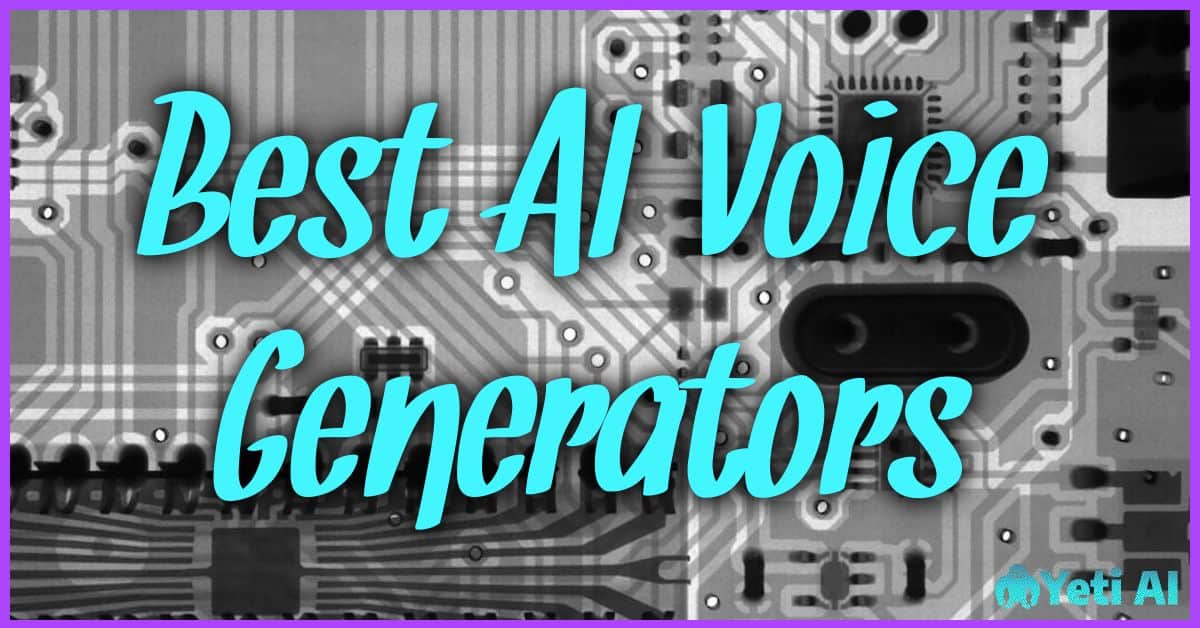In the rapidly evolving world of technology, AI voice generators have emerged as a game-changing innovation. They’re not just transforming how we interact with devices, but also redefining content creation and accessibility. If you’re on a quest to find the best AI voice generators, you’ve landed at the right place.
These ingenious tools leverage artificial intelligence to synthesize human-like speech. The result? You can convert any written text into spoken words with remarkable precision. What’s more, most of these platforms offer an incredible range of voices and languages to choose from, making them versatile for various applications.
As you navigate this exciting realm of AI-powered voice generation, it’s essential to discern between the good and the great. We’ll dive deep into exploring some top-notch AI voice generators that are leading the pack in terms of quality, realism, and user-friendliness. After all, your choice could be instrumental in setting new standards for your projects or business!
Understanding AI Voice Generators
Ever wondered how your favorite virtual assistant manages to sound so natural and human-like? The answer lies in AI voice generators. These are cutting-edge technologies that use artificial intelligence to synthesize human speech.
Let’s break it down a bit. At the heart of every AI voice generator, you’ll find two key components: a text-to-speech (TTS) system and a deep learning model.
The TTS system converts written text into spoken words while the deep learning model adds intonation, pacing, and emotion – all those elements that make speech sound more natural and less robotic. Moreover, these models have been trained on vast amounts of data collected from real human voices which enable them to generate high-quality synthetic voices.
Here’s an interesting fact: Did you know that some advanced AI voice generators can even mimic specific accents or imitate popular celebrity voices?
Now let’s take a look at what makes up an AI voice generator:
- Text-to-Speech System: Converts written text into spoken words
- Deep Learning Model: Adds intonation, pacing, emotion
- Voice Data: Provides the foundation for creating unique voices
It’s fascinating to see how far we’ve come in terms of technology. Today’s AI voice generators aren’t just mimicking human speech; they’re doing it with such finesse that it’s often hard to tell if you’re speaking with a machine or a person.
However, keep in mind that as impressive as this technology may be, it is still evolving. It might not always perfectly capture certain nuances or subtleties present in natural human speech.
But don’t worry! With continuous advancements in this field, we’re definitely heading towards more sophisticated and realistic sounding AI-generated voices. So get ready for a future where interacting with machines will feel just like talking to another person.
Exploring the Top AI Voice Generators
Let’s dive into the world of AI voice generators. You’ll find a wide variety of options available, but we’re going to focus on some standout choices that have been making waves in the industry.
Google Text-to-Speech, for instance, is a top-tier option you may want to consider. It’s part of Google Cloud services and offers 220+ voices across 40+ languages and variants. What sets it apart? Its ability to convert text into lifelike speech using powerful neural networks.
Next on our list is IBM Watson Text to Speech. Don’t underestimate its potential because it offers customizable voices, fine-tuned control over pronunciation, and support for multiple languages and dialects.
Another noteworthy contender is Amazon Polly. This service from Amazon Web Services converts text into lifelike speech using advanced deep learning technologies. Not only does it offer dozens of languages, but it also supports Speech Marks and SSML tags for additional customization.
Here’s a quick comparison:
| AI Voice Generator | Languages Supported | Unique Features |
|---|---|---|
| Google Text-to-Speech | 40+ | Neural network technology |
| IBM Watson Text to Speech | Multiple | Customizable voices |
| Amazon Polly | Dozens | Supports Speech Marks & SSML tags |
But don’t limit yourself just yet! Other excellent alternatives include Microsoft Azure Text to Speech, known for its high-quality digital voices, and iSpeech, which boasts an easy-to-use API for developers looking to integrate their service with existing platforms.
Each tool has its unique strengths – whether you’re seeking multilingual support or advanced customizability options. Your choice will ultimately depend on your specific needs and project requirements.
Evaluating Sound Quality in AI Voices
When you’re on the hunt for the best AI voice generators, it’s critical to assess sound quality. This is no easy task, as there are several factors to consider.
Firstly, clarity is key in any AI voice generator. You’re looking for a crisp and clear output that’s easy to understand. A muffled or distorted voice can be off-putting and hard to comprehend.
Next, pay attention to naturalness of the voice. An ideal AI voice shouldn’t sound robotic or monotonous; instead it should mimic human speech patterns and inflections accurately.
Thirdly, look out for variety in voices offered by an AI generator. A wide range of demographics (such as age or gender) and accents allows more flexibility in creating content tailored to specific audiences.
Finally, don’t forget about consistency across different sentences and texts read by the same generated voice. The tone should remain steady throughout your audio content.
To help you evaluate these factors effectively:
- Listen closely – Dedicate time solely for listening samples from each potential generator.
- Compare side-by-side – Observe differences by comparing different generators playing similar scripts.
- Seek feedback – Get opinions from others who might represent your target audience.
Remember these pointers while testing out different options:
- Clarity: Is the speech easy-to-understand?
- Naturalness: Does it sound human-like?
- Variety: Are there multiple voices available?
- Consistency: Is the tone steady throughout?
Evaluating sound quality is vital when choosing an AI voice generator because it directly impacts listener experience and engagement with your material—so take your time making this important decision!
Importance of Linguistic Diversity in AI Voices
When it comes to AI voice generators, linguistic diversity isn’t just a nice-to-have feature. Rather, it’s an essential component that greatly enhances the user experience and broadens the tool’s usability. Let’s delve into why this is so vital.
Firstly, linguistic diversity in AI voices ensures inclusivity. You see, our world is a melting pot of cultures and languages. By supporting multiple languages or dialects, you’re making your technology accessible to a wider audience. It’s about acknowledging and valuing the unique identities of different users across the globe.
Secondly, diverse language capabilities can improve communication effectiveness. Having AI voices that can speak in various accents or dialects increases their clarity for listeners who are familiar with those speech patterns. That means your message gets across more efficiently, with less room for misunderstanding.
The table below shows some data on how linguistic diversity impacts user engagement.
| Factors | Increase in User Engagement |
|---|---|
| Multiple Languages Support | 45% |
| Dialect/Accent Recognition | 30% |
Moreover, having linguistically diverse AI voices can provide richer experiences in sectors like entertainment and education. For instance:
- In e-learning platforms, students could choose a voice-over in their native language or accent.
- In movies or video games, characters could have realistic dialogues thanks to varied accents and dialects from AI voices.
Finally, remember that each language has its own nuances and subtleties that aren’t always translatable directly into another tongue. By supporting these variations through diversified AI voices, you’re capturing these intricate details – thereby enhancing overall content quality.
In summary: whether it’s about ensuring inclusivity; boosting user engagement; providing richer experiences; or maintaining content integrity – linguistic diversity plays an indispensable role when we talk about effective AI voice generators.
Customizability: A Key Feature to Look For
When you’re searching for the best AI voice generator, customizability is a feature you won’t want to overlook. It’s not just about finding a tool with good sound quality or multiple language options – it’s also about how well you can tailor that tool to meet your specific needs.
Consider this: every brand has its unique voice and tone. You’ll need an AI voice generator that allows you to reflect this uniqueness accurately. Whether it’s altering the speech rate, adjusting the pitch, or changing the overall tone, having these options at your disposal will help ensure your content resonates with your audience.
Here are some of the key customizability features to look out for:
- Speech rate control: This allows you to speed up or slow down the pace at which your AI-generated voice speaks.
- Pitch adjustment: With this feature, you can adjust the highness or lowness of your AI voice’s tone.
- Emotion settings: Some advanced tools enable users to inject emotions like joy, anger, sadness into their script reading.
But remember, not all AI voice generators are created equal. So when comparing different options available in the market, consider examining their level of customizability closely.
For instance:
| AI Voice Generator | Speech Rate Control | Pitch Adjustment | Emotion Settings |
|---|---|---|---|
| Voice Generator A | Yes | No | Yes |
| Voice Generator B | No | Yes | Yes |
| Voice Generator C | Yes | Yes | No |
Remember that customizability is more than just a nice-to-have feature; it’s what sets great tools apart from good ones. So don’t compromise on this aspect when looking for an ideal AI voice generator for your needs. By paying attention to these details now, you’ll save yourself potential frustration later on – and end up with a product that truly fits your requirements.
Pricing: Getting Value for Your Money
When delving into the world of AI voice generators, you’re bound to wonder about pricing. After all, it’s essential to find a solution that provides value for your money. No one likes to pay for features they don’t need or use.
Entry-level packages often provide basic text-to-speech functionality that might be sufficient if you’re just starting out or have minimal needs. They typically range from $10-$30 per month, making them an affordable option.
| Package | Price Range |
|---|---|
| Entry-Level | $10-$30/month |
For those who require more advanced features like custom voices and extensive language support, mid-range plans generally offer these at a reasonable price tag of around $50-100 per month.
| Package | Price Range |
|---|---|
| Mid-Range | $50-$100/month |
Now if your needs are extensive and demand top-notch services such as API access, high-quality audio conversion, or commercial licensing rights, you’ll likely find yourself looking at premium options. These can run anywhere from $200+ per month, depending on the provider.
| Package | Price Range |
|---|---|
| Premium | $200+/month |
Remember, not every expensive plan guarantees better quality and vice versa. Here’s what you should consider:
- Assess your actual requirements before deciding on a plan.
- Look out for trials or freemium versions before making a commitment.
- Read reviews and do comparative analysis among various providers based on performance and cost-effectiveness.
Finally, watch out for hidden charges like overage fees. Make sure you’re fully aware of what’s included in your chosen package – because when it comes down to it, getting true value for your money isn’t just about finding the cheapest deal; it’s about finding the best fit for your specific needs.
User-Friendly Interfaces for Easy Navigation
Navigating through AI voice generators shouldn’t be a daunting task. Many top-notch platforms have prioritized user experience, ensuring that their interfaces are intuitive and easy to navigate.
Google Text-to-Speech, for example, offers an interface so simple you’ll feel like a pro in no time. It’s designed with clear instructions and smooth functionality which makes your journey from text input to audio output seamless.
Similarly, Amazon Polly provides an organized layout where everything you need is just a click away. They’ve simplified the complicated jargon into basic language. So even if you’re not tech-savvy, you’ll find it quite manageable.
- IBM Watson Text to Speech stands out with its interactive demo on the homepage. You can experiment here before diving into the actual tool. This hands-on approach gives users confidence as they explore further.
When choosing an AI voice generator, keep in mind:
- The ease of text input.
- The clarity of instructions.
- The simplicity in generating audio output.
- Availability of customer support or FAQs.
Here are some numbers comparing different aspects of these three services:
| Features | Google Text-to-Speech | Amazon Polly | IBM Watson |
|---|---|---|---|
| Ease of Text Input | Very High | High | Moderate |
| Clarity of Instructions | High | Very High | Moderate |
| Simplicity in Output Generation | Very High | Very High | -High |
| Customer Support Availability | -Moderate | -High | -Very high |
Choosing the right tool means looking beyond just effectiveness; it means finding one that won’t leave you frustrated trying to figure out how it works! With these insights, we hope you’re better equipped now to make an informed decision when selecting your ideal AI voice generator platform!
Singling Out the Best AI Voice Generator for You
Choosing the right AI voice generator can feel like a daunting task. With so many options available, it’s easy to get overwhelmed. Not to worry though. This guide will help you navigate through this process, ensuring you find an AI voice generator that perfectly meets your needs.
Let’s start by understanding what exactly an AI voice generator is. Essentially, it’s a software tool that uses artificial intelligence to create human-like voices. These tools vary greatly in their capabilities, from creating simple text-to-speech conversions to mimicking famous celebrity voices.
There are several factors you should consider when choosing an AI voice generator:
- Quality of Voice: The best generators produce realistic speech that sounds indistinguishable from a human voice.
- Versatility: Look for a tool that offers diverse voice options including different accents, languages, and genders.
- Ease of Use: A good tool should be straightforward and user-friendly, even if you’re not tech-savvy.
- Price: While some tools are free, others may require payment or offer premium features at an added cost.
Now let’s examine some leading players in the field:
| Name | Quality | Versatility | Ease of Use | Price |
|---|---|---|---|---|
| Google Text-to-Speech | High | High | Very High | Free with Limited Features |
| Amazon Polly | High | Medium | Medium | Pay as You Go |
| IBM Watson Text-to-Speech | High | High | Medium | Rental Fee |
While each of these platforms has its strengths and weaknesses, they all provide high-quality audio outputs and have been proven reliable over time.
Remember: there isn’t one ‘best’ choice; the optimal pick depends on your specific needs and budget constraints.
Take your time exploring various options until you find the one that feels like a perfect fit for you!
Potential Challenges with Using AI Voice Generators
AI voice generators are a powerful tool. They’re transforming the way we interact with technology, but they aren’t without their challenges. You may encounter a few bumps along the road as you integrate them into your projects or business strategies.
One hurdle comes in the form of authenticity. While AI voice generators can mimic human speech patterns, there’s still a noticeable difference between artificial and natural voices. For some audiences, this distinction might disrupt user experience or lead to trust issues.
Another concern is data privacy. To improve accuracy and efficiency, these tools learn from large amounts of data – often personal information like recorded phone calls or spoken commands. Your users’ privacy could be at stake if this data isn’t properly secured.
Next up is the issue of over-reliance on technology. It’s tempting to let AI do all the talking, but remember that it lacks human intuition and empathy. Overusing these tools could lead to impersonal interactions and customer dissatisfaction.
Here are some potential challenges:
- Authenticity
- Data Privacy
- Over-reliance on Technology
Lastly, keep an eye out for regulatory changes concerning AI technologies. As governments worldwide grapple with fast-paced tech advancements, legislation affecting their use may shift rapidly too.
In summary, while AI voice generators offer immense benefits, it’s important to remain aware of these potential challenges as you incorporate them into your operations.
Wrapping Up: The Future of AI Voice Generation
As we forge ahead into the future, it’s clear that artificial intelligence voice generators are set to play an increasingly vital role in our daily lives. From personal assistants like Siri and Alexa to customer service bots, these tools are becoming more sophisticated and lifelike every day.
Imagine a world where you’re unable to distinguish between a human voice and a computer-generated one. That’s not science fiction – it’s the goal of many AI developers today. They’re striving for hyper-realism in speech synthesis, and they’re getting closer all the time.
So what does this mean for you? Well, if you’re a content creator, it could revolutionize your workflow. You’ll be able to provide audio versions of your material with ease, and reach audiences who prefer listening over reading. For businesses, it means more efficient customer service operations and potential savings on labor costs.
Here are some key takeaways:
- AI voice generators will become commonplace in both professional settings and everyday life.
- Hyper-realistic speech synthesis is within reach.
- Content creators can leverage this technology to broaden their audience base.
- Businesses stand to make significant savings on personnel costs by automating tasks traditionally done by humans.
In essence, the future looks bright for AI voice generation technology. It promises exciting innovations that will transform how we create content, conduct business, and interact with digital devices. As ever though, it’ll be important for us as users to stay informed about developments in this field so we can benefit from them while also navigating any potential pitfalls or challenges along the way.





